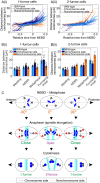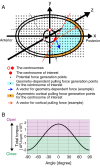Choice between 1- and 2-furrow cytokinesis in Caenorhabditis elegans embryos with tripolar spindles
- PMID: 30785847
- PMCID: PMC6727771
- DOI: 10.1091/mbc.E19-01-0075
Choice between 1- and 2-furrow cytokinesis in Caenorhabditis elegans embryos with tripolar spindles
Abstract
Excessive centrosomes often lead to multipolar spindles, and thus probably to multipolar mitosis and aneuploidy. In Caenorhabditis elegans, ∼70% of the paternal emb-27APC6 mutant embryonic cells contained more than two centrosomes and formed multipolar spindles. However, only ~30% of the cells with tripolar spindles formed two cytokinetic furrows. The rest formed one furrow, similar to normal cells. To investigate the mechanism via which cells avoid forming two cytokinetic furrows even with a tripolar spindle, we conducted live-cell imaging in emb-27APC6 mutant cells. We observed that the chromatids were aligned on only two of the three sides of the tripolar spindle, and the angle of the tripolar spindle relative to the long axis of the cell correlated with the number of cytokinetic furrows. Our numerical modeling showed that the combination of cell shape, cortical pulling forces, and heterogeneity of centrosome size determines whether cells with a tripolar spindle form one or two cytokinetic furrows.
Figures







Similar articles
-
Analyzing the effects of delaying aster separation on furrow formation during cytokinesis in the Caenorhabditis elegans embryo.Mol Biol Cell. 2010 Jan 1;21(1):50-62. doi: 10.1091/mbc.e09-01-0089. Epub 2009 Nov 4. Mol Biol Cell. 2010. PMID: 19889842 Free PMC article.
-
C. elegans chromosomes connect to centrosomes by anchoring into the spindle network.Nat Commun. 2017 May 11;8:15288. doi: 10.1038/ncomms15288. Nat Commun. 2017. PMID: 28492281 Free PMC article.
-
Cytokinetic furrowing in toroidal, binucleate and anucleate cells in C. elegans embryos.J Cell Sci. 2008 Feb 1;121(Pt 3):306-16. doi: 10.1242/jcs.022897. Epub 2008 Jan 15. J Cell Sci. 2008. PMID: 18198185
-
Cytokinesis in the C. elegans embryo: regulating contractile forces and a late role for the central spindle.Cell Struct Funct. 2001 Dec;26(6):603-7. doi: 10.1247/csf.26.603. Cell Struct Funct. 2001. PMID: 11942615 Review.
-
Mitotic spindle multipolarity without centrosome amplification.Nat Cell Biol. 2014 May;16(5):386-94. doi: 10.1038/ncb2958. Nat Cell Biol. 2014. PMID: 24914434 Review.
Cited by
-
Enucleation of the C. elegans embryo revealed dynein-dependent spacing between microtubule asters.Life Sci Alliance. 2023 Nov 6;7(1):e202302427. doi: 10.26508/lsa.202302427. Print 2024 Jan. Life Sci Alliance. 2023. PMID: 37931957 Free PMC article.
-
From DNA damage to epithelial integrity: new roles for cell forces.Mol Biol Cell. 2019 Jul 22;30(16):1879-1881. doi: 10.1091/mbc.E19-06-0338. Mol Biol Cell. 2019. PMID: 31322996 Free PMC article. No abstract available.
-
Cytoplasmic streaming drifts the polarity cue and enables posteriorization of the Caenorhabditis elegans zygote at the side opposite of sperm entry.Mol Biol Cell. 2020 Jul 21;31(16):1765-1773. doi: 10.1091/mbc.E20-01-0058. Epub 2020 May 27. Mol Biol Cell. 2020. PMID: 32459552 Free PMC article.
References
-
- Boveri T. (2008). Concerning the origin of malignant tumours by Theodor Boveri. Translated and annotated by Henry Harris. J Cell Sci (suppl 1), 1–84. - PubMed
-
- Bringmann H, Hyman AA. (2005). A cytokinesis furrow is positioned by two consecutive signals. Nature , 731–734. - PubMed
-
- Brinkley BR. (2001). Managing the centrosome numbers game: from chaos to stability in cancer cell division. Trends Cell Biol , 18–21. - PubMed
-
- Colombo K, Grill SW, Kimple RJ, Willard FS, Siderovski DP, Gönczy P. (2003). Translation of polarity cues into asymmetric spindle positioning in Caenorhabditis elegans embryos. Science , 1957–1961. - PubMed
Publication types
MeSH terms
Grants and funding
LinkOut - more resources
Full Text Sources

